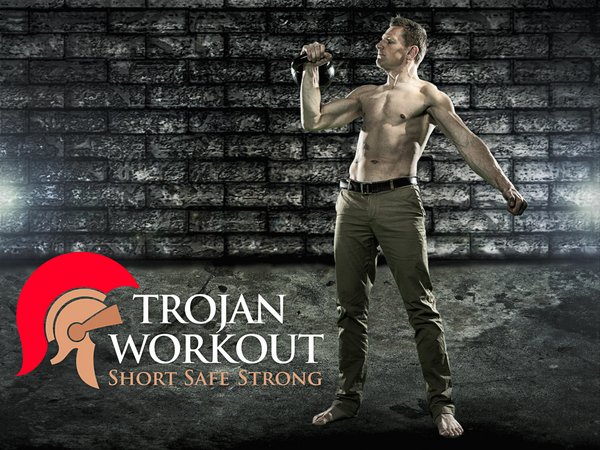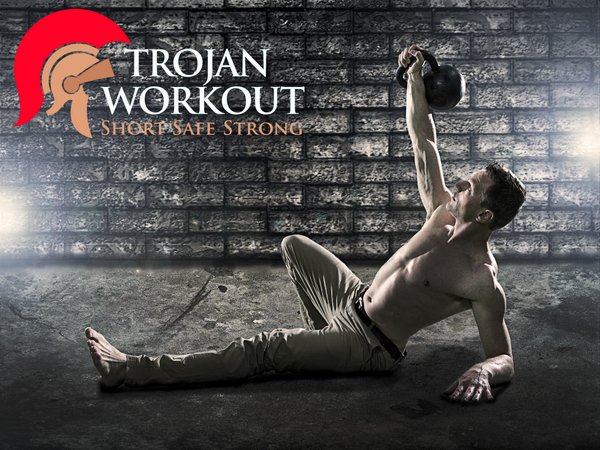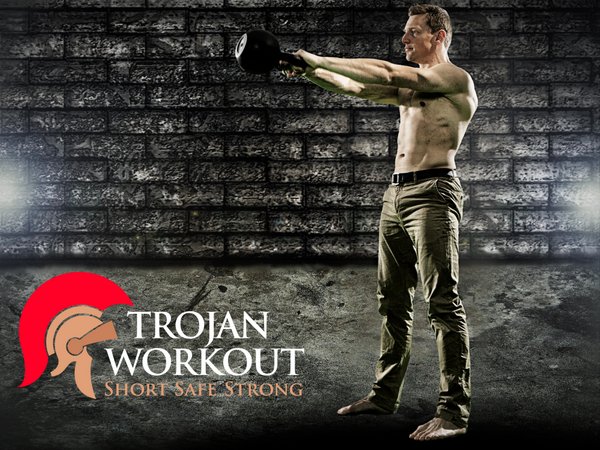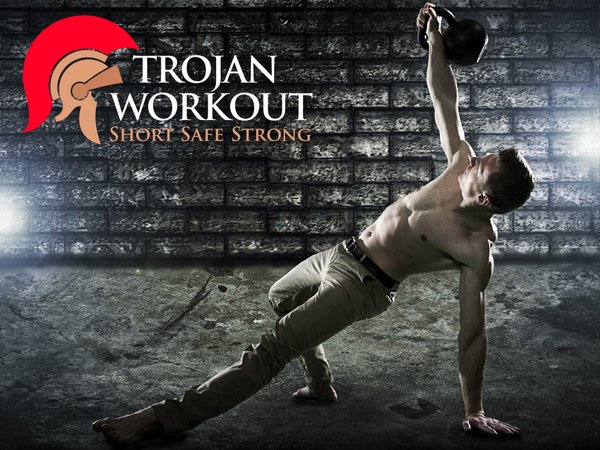An Interview with Martijn Bos PCC, FMS and RKC Instructor
By Adrienne Harvey, SrPCC, RKC-II, CK-FMS, Primal Move Nat’l Instructor

Dragon Door: How did you first find out about kettlebells and the RKC?
Martijn Bos: I had been training with kettlebells for several years before taking any of the RKC courses. Trying to learn and practice just from manuals—and another certification in Holland which was not that great—was definitely a mistake. When I started training for the RKC snatch test, I can remember practicing it at home before my first RKC and barely being able to do 101 snatches in five minutes. But at the
RKC, after learning the right hip hinge and the right movement, I could suddenly do 120 snatches in five minutes.
Now I have developed a method called Trojan Workouts which uses bodyweight and kettlebell exercises, and the training sessions are 30 minutes or less. I am also experimenting with how to measure hormone levels. Students from the University in Haarlem tested the Trojan Workouts method. In their 8-week research project, one group did the Trojan Workouts twice a week, while the other group did 1.5 hours of conventional fitness training on machines—30 minutes of cardio on a machine, then 1 hour of strength training on machines. After 8 weeks, the research showed that to equal the effects of 8 hours of Trojan Workouts, you’d need to do 28.5 hours of regular fitness training.
Dragon Door: What inspired you to start developing the Trojan Workouts?
Martijn Bos: I was inspired by the ideas in some movies and training video clips I saw a long time ago. Then I started to research protocols like Tabata, and others related to working out for short and intense sessions for better results. I used to be a gymnastics teacher, and taught physical education at a secondary school. At the sport academy in Holland, I learned a lot about didactics—the method of teaching.
Through my research, I found out that many people were not training to get results, but were only training to get tired during their session. But, these same people also want to be strong, healthy, and look good naked. Unfortunately, what they usually do is start running for miles and miles and miles or work out in ways that are really fatiguing to their bodies. I don't believe that fatigue is the way to achieve the results that they want. So, about 8 years ago, I started to experiment with offering 30 minute workouts at my Krav Maga gym.

Dragon Door: What kind of results were your students at the gym getting with these 30 minute workouts?
Martijn Bos: Muscle gain, but mostly they got much stronger. Since people seem to mainly train to improve how they look, I explained to them that they should train to improve how they feel and perform—then, their looks will change too.
Soon, they were commenting about suddenly being able to see their
abs. Many of the women said that they no longer had skin hanging on their arms and that their butts were starting to get more round—that kind of thing. They also noticed that they could help a friend moving all day without getting tired.
Dragon Door: How do kettlebells fit into the workouts?
Martijn Bos: I think with
kettlebell training, you move the way your body is designed to move. In the Trojan Workouts, we also emphasize using your body the way that it's designed to move, and how it is used in daily life. When people get stronger in this way, they are often much happier.
This is especially true for kettlebell and
bodyweight training—you have to do it all, you can’t just lean on a machine or sit down, you have to do the exercises.
Dragon Door: Are both men and women training with you?
Martijn Bos: Yes, but there are definitely more women coming to the Trojan Workouts. I think that women have started to change their views on how they should train. Five years ago, I remember all the ladies wanted to avoid strength training because they were afraid of getting big and muscled. But now the opposite is happening, they are getting lean, strong, and are very satisfied with how they look. They don’t have huge biceps or anything either, I think that idea is something people like to believe so that they don't have to achieve their goals!

Every once in a while when I invite someone for a workout they might make a comment like, "I don't want to get big." So, I have to convince them that it doesn’t work that way. But I think the fitness world is changing, and strength training is becoming more accepted. When they finally show up for a Trojan Workout, they leave satisfied and realize that they are not dead tired afterwards. That's an important part of the workouts—stop before you are completely fatigued. If you were a Trojan, you would need to train this way so that you could defend yourself even after working out.
Dragon Door: Why you chose to call the program Trojan Workouts?
Martijn Bos: I chose it because of the philosophy—the Trojan civilization is not as far from us as the cavemen, but they still did not have sitting jobs, cushy shoes, and the luxury of nearby supermarkets.
Dragon Door: Do you mostly train groups?
Martijn Bos: I do some private training, but the Trojan Workouts are for groups of 15-20 people—the group dynamic works really well. We also use many partner exercises, and I think people achieve more in a group.
Dragon Door: Going back to your own training, what results have had with kettlebells?
Martijn Bos: I got much stronger, really fast! I didn't gain a lot of muscle mass—gaining mass wasn't my goal because I wanted to keep my speed.
Kettlebell training is especially good for Krav Maga because you train explosively while also training for strength and movement. When people are doing Krav Maga and Trojan Workouts at my gym, you can really see the difference. They're strong, developed, and skilled with Krav Maga.
Dragon Door: When did you begin studying Krav Maga?
Martijn Bos: I started Krav Maga in 2000 with the IKMF, the largest organization in the world at that time. I was also the first student in Holland. Right now I am one of the highest level Krav Maga instructors outside of Israel. Teaching is my full time profession now—I teach everyone from private security personnel to kids. At Trainingscentrum Helena, I have a group of 14 instructors now who do a great job. I’ve had the gym open for about ten years. Lately, I have put my focus on the women’s division.
We have also developed a three month small group program called Femmepowerment. They learn the basics of self defense and parts of the Trojan Workouts so that they can feel strong and get strong. In the program, I also teach verbal skills, mental skills, and breathing techniques all with the goal of the students feeling better about themselves and performing better in daily life, work, and relationships.
Dragon Door: Why did you start studying Krav Maga?
Martijn Bos: I was bullied at school when I was young, but always had my heroes like Bruce Lee and Jean-Claude Van Damme. Although I loved martial arts and the Way of the Samurai, it always seemed like something was missing—the practical practice. There are many philosophies of self-defense but basically they are martial arts, what Krav Maga really offers is self defense. Krav Maga is not a sport, you are investing in your life and safety. After seeing a demonstration years ago on Eurosport, I realized that that I wanted to study Krav Maga. The guy doing the demo was dealing with multiple opponents, striking to the groin, and defending against weapons only using his hands.
By coincidence, someone who had learned Krav Maga in Israel was beginning to teach in Holland. I was his first student. After the first lesson I realized that this was what I wanted to study and the big difference between a competition fighting sport, marital arts, and self defense.
Dragon Door: You recently attended the PCC, then hosted a PCC Workshop at your gym, what do you like most about the program?
Martijn Bos: It was great fun! Al and Danny did a great job, John Du Cane was there and it was really nice to meet him. In developing my workout programs, I wanted to attend many courses abroad, and one that I really liked was the
PCC. I wanted to bring more knowledge to Holland because right now I am the only certified RKC instructor in Holland.
There’s a lot of horrible technique happening with kettlebell and bodyweight exercise in Holland. Because of all the untrained gym owners and personal trainers trying to teach without learning the techniques, the kettlebell has gotten a bad name. Training a group without a solid knowledge base of how to use a kettlebell is horrible—and the same is true with bodyweight exercise. So many times we see private trainers working with clients at the beach or in the park and their client can’t even perform a safe push up—yet the trainer is screaming at them to keep doing it.
There’s really a lack of knowledge about kettlebells and bodyweight exercise in Holland, so I wanted to improve the level of instruction here.
Dragon Door: What moves from the PCC and RKC are you working on right now?
Martijn Bos: Something I like about bodyweight training is that there’s always something different to try. And sometimes when you gain one move, you might lose another one. When I was working on
one-arm one-leg push ups, and could do 5 reps on each side, I couldn't do a muscle-up! Now I can do two, which is not great but as I keep improving the
muscle-up, I will probably lose the push up. Next, I want to try the front lever.
Since I am doing the
RKC-II in March next year and want to press the
48kg at least more than once, I am also working on presses. But, I always like to do heavy kettlebell swings. The great thing about kettlebell training is whatever I train, it improves my performance in Krav Maga—especially with stamina and strength—that’s the "what the hell" effect!

Dragon Door: I remember we’d talked a few years earlier, but you had had a serious injury. How did you recover from it?
Martijn Bos: Two years ago I had an accident and ruptured the cross and lateral band in my knee, along with the meniscus. In Holland they call this injury an "unhappy triad", one bad movement rips both your outside ligament, the cross ligament, and the meniscus. At the hospital, the doctor said that I would need to adjust to the idea that my knee would never perform normally again.
I could not believe it, and asked for a second opinion from a knee specialist. He said that if I had just one rotation within my first two months of recovery then I probably would not be able to use my knee normally ever again. I kind of ignored his advice and started working out the next day using my Trojan Workout principles (don't get completely fatigued, quality over quantity—aim for perfection in your movements). I did squats, presses, and many other exercises every day without really getting tired.
At first, my cross ligament was damaged to the point that an MRI showed that there was only 12 percent left. After a few months I went back for another checkup on my knee, and a second MRI showed that it had improved from 12 to 70 percent!
The first doctor had advised me to find a new profession, and the second one had advised me to make sure my knee didn’t rotate. I went back to the second doctor who admitted that even though he could not give me the advice to work out with my injured knee, he agreed that in some cases what I did could work if you are very careful and know what you are doing. To be honest, now my
pistol on my damaged knee! I think that the training approach I’ve developed has really shown its value.
Dragon Door: Do you have a sample workout from your method that you'd be willing to share?
Martijn Bos: One example is a combination of heavy planking (RKC style planks) and heavy swings. After planking, do 10-15 heavy swings, then rest until your breathing pattern recovers to the point that an exhalation takes longer than the inhalation. If you have mostly recovered, then you can breathe out for longer than when you breathe in.
I am always working with groups, and don’t like those workouts when people are just following a workout on the wall with no group dynamic. But, since there are people of all fitness levels in our groups, we have to work with progressions. Some people in our groups are 18, and they might be in the same group as someone who is 65—but they are all doing the same basic workout. The 18-year-old may catch his breath faster, but with these methods, everyone works out to their best abilities. There are also hardly any injuries in my classes.
Back